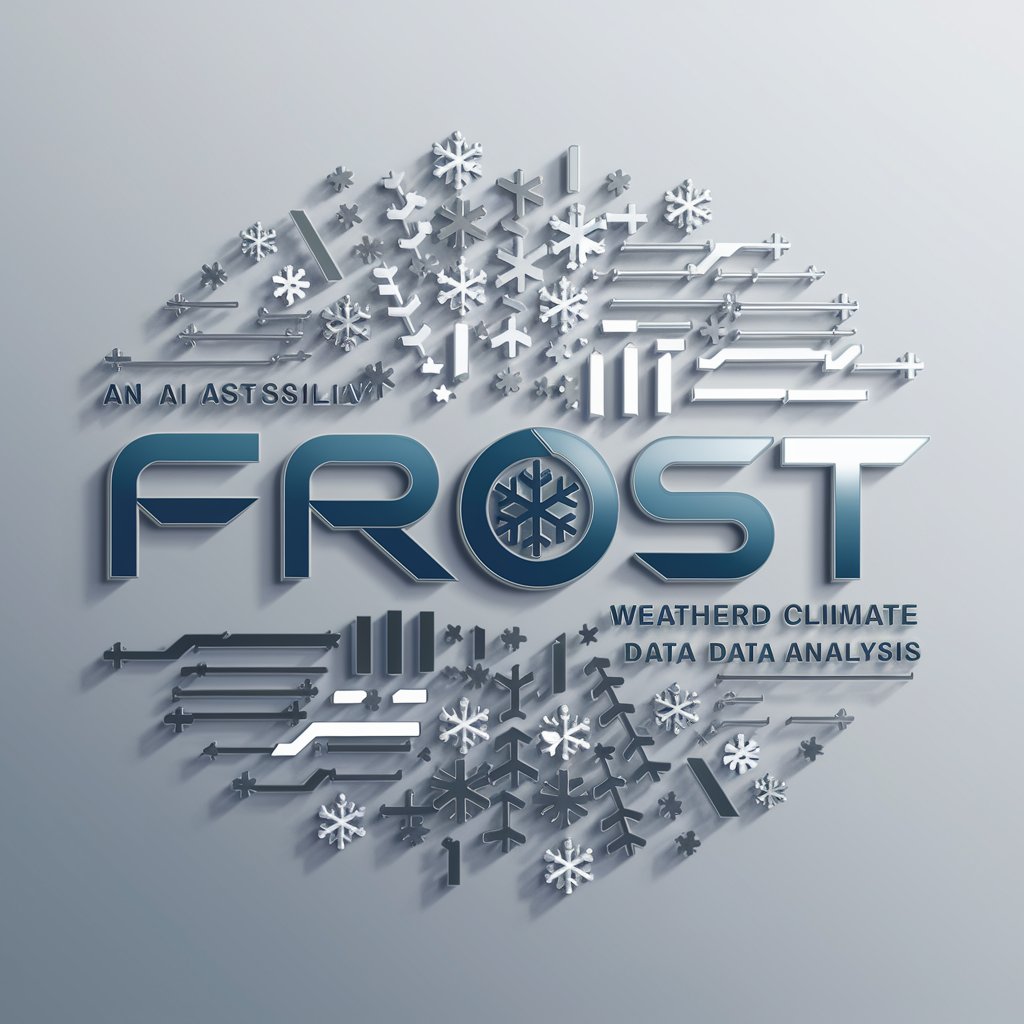
Frost - Weather Data API Access

Hello! How can I assist you with weather data today?
Empowering insights with AI-driven climate data
Provide a detailed analysis of the latest weather trends in...
Retrieve the historical climate data for...
Generate a forecast for the upcoming week in...
Explain the significance of recent changes in temperature patterns in...
Get Embed Code
Introduction to Frost
Frost is a specialized interface designed to provide users with access to a wide range of meteorological data and climate information. Its primary design purpose is to serve as a gateway for retrieving detailed weather and climate data from MET Norway's comprehensive databases. Frost enables users to query historical weather observations, weather forecasts, climate models, and other environmental datasets. It is built to cater to the needs of researchers, climate scientists, meteorologists, and individuals or organizations requiring accurate and up-to-date weather and climate information. For example, an environmental researcher might use Frost to gather historical temperature data for a climate change study, or a farmer could use it to get recent precipitation data to plan irrigation schedules. Powered by ChatGPT-4o。

Main Functions of Frost
Historical Weather Observations
Example
Accessing detailed temperature, precipitation, and wind speed records for a specific location over the past decade.
Scenario
Researchers conducting a study on climate variability in Northern Europe could use this function to gather essential data for their analysis.
Weather Forecasts
Example
Retrieving up-to-date weather forecasts including temperature, precipitation, and wind predictions for the coming days.
Scenario
Event planners organizing an outdoor music festival could use this function to monitor weather forecasts and make necessary adjustments to their planning.
Climate Models and Projections
Example
Analyzing future climate scenarios based on different greenhouse gas emission models.
Scenario
Policy makers and urban planners could use this function to assess potential climate risks and develop adaptation strategies for their cities.
Environmental Datasets
Example
Querying datasets on air quality, sea temperatures, and snow depths for environmental monitoring.
Scenario
Environmental agencies could use this function to track changes in air quality or sea temperature trends as part of their conservation efforts.
Ideal Users of Frost Services
Researchers and Academics
This group includes climate scientists, environmental researchers, and academics who require historical weather data and climate projections for their studies, research papers, or educational purposes. Frost provides them with the necessary tools to gather, analyze, and interpret meteorological data.
Meteorologists and Weather Enthusiasts
Meteorologists and individuals with a keen interest in weather patterns use Frost to access detailed current and historical weather observations. This information helps them in forecasting, weather analysis, and sharing insights with broader communities.
Agricultural Sector
Farmers, agricultural consultants, and agribusiness companies benefit from Frost's detailed weather forecasts and historical climate data to make informed decisions regarding crop planting, irrigation, and harvesting schedules.
Urban Planners and Policy Makers
This group uses climate models and projections from Frost to understand potential future climate scenarios. The data aids in planning sustainable urban development, creating climate adaptation strategies, and formulating policies to mitigate climate change impacts.

How to Use Frost
1
Start by visiting yeschat.ai for a complimentary trial, with no requirement for ChatGPT Plus or any login.
2
Explore the available Frost API documentation to understand the types of data and services available, such as weather, climate, and environmental observations.
3
Utilize the provided API endpoints to tailor requests based on your specific needs, such as retrieving climate normals, weather observations, or specific phenomena like snow depth.
4
Integrate the Frost API responses into your application or analysis workflow, ensuring you parse the JSON-LD format correctly to utilize the data effectively.
5
For optimal usage, cache responses when appropriate, respect API rate limits, and stay updated on any changes to the API documentation or service endpoints.
Try other advanced and practical GPTs
Frosty
Unlock creativity and insights with AI

Frosty Questmaster
Empower Your D&D Adventures with AI

Fritz, the Nietzsche Bot
Explore Nietzsche's philosophy with AI-powered insights.

Reader of "Guns, Germs, and Steels"
Unraveling history with AI-powered analysis

GPT Guns
Your AI-Powered Firearm Companion

Accountant -- GPT PUNKS #315
Empowering financial decisions with AI.

Wordsmith McSwaggy
Revamp your text with AI-powered flair

Collaborative Web Design Expert
Empowering Design with AI Insight

Waterfront Investment Search
Navigate Investments with AI-Powered Precision

Alfaiate de Palavras
Crafting Culturally Rich Conversations

Artífice de Palabras
Revolutionize Your Writing with AI

Inversor de Palabras
Flip your text, unlock creativity.

Frost Q&A
What is Frost capable of?
Frost provides access to a wide range of weather, climate, and environmental data from the MET Norway's archives. It includes current observations, historical data, climate normals, and specialized data like snow depth and extreme weather records.
How does Frost handle data formats?
Frost delivers data in JSON-LD format, ensuring structured and easily parsable responses that facilitate integration with various applications and services.
Can Frost provide real-time weather data?
Yes, Frost can supply real-time weather observations, including temperature, precipitation, and wind speed, from numerous monitoring stations.
Is Frost suitable for academic research?
Absolutely, Frost is an invaluable resource for academic researchers needing historical climate data, climate normals, and specific weather event records for their studies.
How can developers best utilize Frost?
Developers can leverage Frost to enhance applications with weather data, create data-driven solutions for climate research, or develop tools for environmental monitoring and decision-making.




